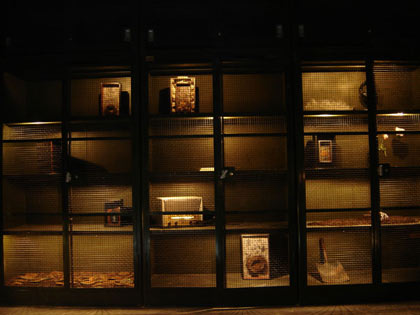|
|
| home | exhibitions | interviews | features | profiles | webprojects | archive |
|
Steve Messam on Cumbria and art in rural areas of the UK Steve Messam is founder of 'Fold Gallery', Cumbria and 'FRED: an art invasion'
Steve can we start by setting the scene for readers who, like myself, are not that familiar with Cumbria and adjacent areas in the North of England. Like Cornwall, you have your own literary and artistic legacy, which is both a blessing and a curse. Can you sketch this legacy out for us?
Cumbria is the top right-hand corner of England – last stop before the
Scottish Borders. The Lake District is the
very centre of the county and draws over 16 million visitors each year –
mostly to gawp at the landscape – all mountains and lakes, and its
cultural legacy. Literary giants include Wordsworth -
born and died here along with romanticism -
and Ruskin has a big presence in the south and almost every writer of note in the 19th Century took up camp here at some point or other - Decourcy even ran the local paper for a while to stir things up a bit. So you could say we have a tradition of outsider thinking here. Kurt Schwitters lived and died in Ambleside (picture: Merzbarn right) and we’ve had at least 2 Turner Prize winners born in the area. However, most visitors miss out on the real gems of the county – the best lakes are to the west of the centre honey pot. The coastline is breathtaking in parts and includes the cockle shelves of Morecambe bay. We also have the nuclear submarine builders in Barrow in Furness and then there’s Selafield. Like Cornwall, there is a huge amount of ‘Sunday watercolourist’ product about and forms the staple of almost all the galleries in the county. There’s also a long ceramic tradition in the Penrith area, which is patchy at best.
Ceramics are pretty big in Cornwall, too.
So what
opportunities were there during the 80s and 90s for looking at
contemporary art in the area, and what led you to set up FOLD in 2001?
Are there biggish public galleries in the area, or perhaps smaller
commercial galleries? What role did Grizedale have at the time, and what
was the relationship like between these various
components? Although I wasn’t living in the area during the 80’s and most of the 90s, I can quite confidently say it was a much different place. Contemporary art was occasionally seen at Tullie house in Carlisle, but not really. Grizedale was set up in the early seventies and by the eighties was seen as a bit of a landmark (picture Andy Goldsworthy right). It had a permanent collection of “land art” and work in the forest environment way ahead of its time. By the 90's the Brewery Arts Centre had been established and it had an on and off programme of contemporary art. However, if you wanted to see what was really going on, you still had to go to the Burrell in Glasgow, or the galleries in Manchester. Commercial galleries selling contemporary work of any note were non-existent – and still remains the case today by and large. In 1996, we had the year of visual arts in the North (we were still in the northern region for arts council until 2002). In that year there was a huge amount of work going on in the region and you could really see the sheer volume of contemporary artists working at that time. On the back of 1996, the North East, and Newcastle/Gateshead in particular felt it important to maintain the momentum, recognising the value art had in regenerating and rebranding the area. This led directly to the Baltic and Sage centres on Gateshead Quay, the Culture 10 programme and the new institute of modern art in Middlesbrough. Cumbria county council, on the other hand said ‘very nice – let’s move on now’, and in 2000 we finally lost the visual arts and literary officers for the county. In fact, art now comes under ‘Community and Regeneration’ officers. In the late 90s, Grizedale changed director and consequently changed direction. Out went the Goldsworthy, Nash and the likes and they gradually moved away from creating works in the forest. In 2004, Grizedale Forest and Grizedale Arts rather acrimoniously went their separate ways. Grizedale Arts is only now addressing the cultural needs of the county and occasionally works with rural artists.
The Goldsworthy, Nash etc works at
Grizedale Forest are slowly disintegrating. The Nash has been there
over 30 years and takes some uncovering.
Goldsworthy also did a series of works on 60-odd sheepfolds
across Cumbria 1999 - 2006. We have 3 round here as he used to live
in the next village (picture left).
We set up Fold Gallery in 2001 in response to the lack of exhibition space for contemporary artists. Although there were a number of international artists living and working in the area, there was nowhere between St Bees on the West coast and Whitby on the North Yorkshire coast to show work of a non-commercial nature. By then, even the Brewery in Kendal was a closed shop to new artists. It was done on the basis that if I’m doing work here but can only show it in Glasgow, London, Paris and New York, I can’t be the only one.
How does FOLD operate? On the website the gallery is described as an ‘artist-led initiative’. Can you unpack this a bit more? Is it a non-profit making space? Is it run by committee and if so how are decisions made regarding who or what is shown there?
Fold gallery is a 4-metre cube (like the original white cube in London) where we show largely non-commercial work. The programme is a mixture of work by other rural artists, or curated shows with a local relevance. Artists are either selected from open submissions or drawn from an ever-increasing network of rural artists from the UK and beyond. Although the gallery is not commercial, we invariably sell something from every show. Personally I’ve drawn on a lot if influences from City Racing in London in the early 90s – disused shop, varied programme of interesting non-commercial work, no money, that kind of thing.
Moving onto FRED - lots of artists making site-specific work in Cumbria - how many FRED events have there been? Can you try and describe each one? FRED was the result of trying to find an alternative to open studios for artists like me who largely work to commission only. We (fellow artist Kate Brundrett and me) travelled the region and spoke to over 250 artists about what they would like to do. It was as much about raising the profile of artists within their own communities as anything else. The first FRED was run in part to help Kate realise an artists network for Cumbria, and partly to raise our own profile. The first FRED was done for a total budget of about 10K. Five thousand went on paying a coordinator to keep track of all the artists taking part. It was a real shoestring job but had bucket loads of commitment from the artists taking part. We commissioned a work by Adele Prince to go on the back of car park tickets in the Lake District for the week. Over 250,000 tickets went – which gave us a good starting audience figure. The work also got onto the news on all the BBC radio stations – starting with the Today programme on Radio 4 giving us a huge kick in the PR stakes. The phone didn’t stop ringing all week with media requests. The Arts Council, who had turned us down for funding in preference for a team of consultants, to look into the idea of a countywide visual arts event – gave us some guilt money towards publishing a book of the event.
FRED number 2 was in some respects easier – we got some more money in and had the media success of the first event. We commissioned Graham Rawle (who did Lost Consonants in the Guardian) to do the marketing, which was well received universally, despite some initial art snobbery from some quarters. Our major PR coup was getting Jenny Holzer to do a piece for the back of receipts at the service station on the M6. Jenny lives and works in the Catskill mountains, related to the plight of rural artists not showing in rural areas, and actually took part on the same terms as all the other artists – they get materials and expenses only – but get to do the work they really want to without the administration or project management hassles. We extended FRED to 16 days and gave away over 500,000 Jenny Holzer originals in that time alone. We had some really beautiful and considered work in the second year and employed a photographer to document it all. One of the bigger pieces was a necklace of lights around Old Man Coniston – one of the most popular mountains in the lakes (Charles Monkhouse: picture below left). Although on for only 4 nights the lights could be seen right around Morecambe Bay and beyond – over 40 miles away. Although the TV failed to pick up on it, it’s one of the pieces that’s stuck in the memories of anyone living south of the lakes that year.
We are now progressing with FRED 2007 and 2008. We haven’t got all the funding in place yet, but have a really exciting programme lined up. We are constantly evaluating the events and gradually programming more ahead. Our ambition is to upstage the capital of culture stuff in Liverpool in 2008 – something well supported locally as it seems that Liverpool and Manchester get the lions share of arts funding in the North West and it’d be good to show what can be done for a fraction of the budget.
Ambition is the word. I'm impressed. How did you get Jenny Holzer to take part?
I just emailed
her. The same goes for Graham Rawle and
the other 'names' we've got lined up for the next couple of years.
If you don't ask you don't get. I took the 'fellow artist' approach
as many artists of her calibre can often feel removed from their
roots. As an artist I know how most commissions are merely
variations on a theme that someone has seen before, and that it's
sometimes difficult to do things just for the hell of it.
Also, how often do people in darkest Cumbria get to see work by Jenny Holzer and the like? I have to say it was quite funny putting the work of one of the 20th century's foremost feminist artist in the hands of hundreds of thousands of burly truckers.
I’ve seen reproductions of 'Balls to Grasmere', and the Fairy Sign
pieces which are examples of your own work. Were
these pieces contributions to ‘FRED’?
Both seem very contemporary and very accessible, and though placed in
the landscape neither seem obviously related e.g.
to Land Art of the Andy Goldsworthy school. The 'Balls to Grasmere' piece wasn’t strictly a FRED piece – it was funded by the Tourist Board to promote the area out of season and give FRED a bit more exposure as the kind of thing they want to see in the county. Actually, the Fairy signs piece was n’t created for FRED either. It was first shown in Yorkshire, but I’d promised the organic farm near Kendal we would give them something for FRED again after they hosted a wind turbine made from air-dried ham the year before and loved the exposure. ‘Balls to Grasmere’ (a half-mile installation of large red balls on Wordsworth’s hallowed lake) apparently drew 4,000 a day to see it according to the National Trust. It was the kind of work that I’ve always wanted to do, but like most FRED artists, had never had the chance to do before. The publicity they gained has been great for my own career and I’ve benefited nicely from it in other commissions. Like all (non-commissioned) FRED artists I wasn’t paid for the work, but the freedom the opportunity gave me has more than paid off. I see this as one of the main benefits for artists doing FRED. I’m not a great believer in relying on the Arts Council to pay for art. As an artist, making art should be something you do regardless. There are plenty of other opportunities to make a living as an artist. I personally have never received a penny from Arts Council for any of my works. You just have to be prepared to take the opportunities that come along and work them to your own creative benefit.
Although not representative of FRED as a whole, I think the strength in FRED lies in the scale of the landscape we have here – something I’m sure will be played with increasingly over the next two years.
How do you measure the success of a venture like FRED? How has it gone down with the national press or art-mags, and does that matter to you? How has it gone down with local people? FRED is only a success if the people taking part and the people going to it have a good experience. FRED was also going to be an organic event, and it duly grows each year. I don’t think we’ve done what I really wanted to do yet, but we’re definitely going in the right direction.
On that front, I’m not really bothered about art press coverage. I know how other curators around the UK and abroad receive it by meeting them. Locally, it’s really for the people who live and work here. The level of coverage and support we get in the local press means that by now most people know about FRED and have even seen it. How many locals in other art cities can claim that? Last year I went round a few B&Bs to pay for artists’ accommodation and chatted with the owners. Almost all of them had been out to visit FRED pieces – some even travelling large distances to see pieces they’d seen in the paper or heard about on the radio. Even the staff at the farm supplies where we got a lot of materials for Richard Box’s piece, know all about it as the farming community were talking about it. If local people didn’t get it, we wouldn’t be doing it at the end of the day.
Interestingly, whilst there is landscape painting, there is not much of a tradition of making Land Art or eco-art in Cornwall - which has always struck me as strange and unfortunate. Would you agree that if, as an artist, you live in a rural place it makes sense that this experience should inform the work? Is there - in this sense - such a thing as rural art?
I think there is definitely an urban art. It’s everywhere in the art and
design press. It is full of the cultural reference points you find in an
urban environment – from the colours to the influence of street art,
billboard advertising, music and the art world inbreeding of ideas you
get when you put too many artists in small areas. This I think leads to
a culture of emperor’s new clothes critique. When you look at something
like the Haywood’s Big Art Show as a baseline – there’s an awful lot of
crap out there passing as the next best thing.
Rural art, by its isolation from that scene renders it more diverse. It naturally has a whole new set of cultural reference points, which are largely lost on urban audiences. An example is in the work of Russell Mills ('HOLD': photo right). Russ shows all over the world. He has designed videos for the likes of David Sylvian and Nine Inch nails. He is one of the top UK artists in the Japanese market. And yet, when we showed his work in the gallery, local people could spot the colour pallet as being distinctively Cumbrian. The found objects he uses in his work were familiar everyday sights for our audience and his work took on a much more local relevance – without even saying where he lives. I think the craft culture inherent in rural communities plays a part too. We find that work produced by rural artists is finer in its creation than most urban art. I believe that rural artists are much more connected with the origins of their medium than urban artists, this may stem from being closer to the land and naturally having a better understanding of where their food comes from – you see it in the fields every day. Consequently, rural artists are much more likely to experiment with the raw materials of their medium – painters are more likely to mix their own paint, or at least know how it’s made. Life is slower and therefore there is more time to experiment with the medium. I guess there’s also an element of resourcefulness involved – previously photographers were more likely to process and print their own work if only because there isn’t anyone else around to do it. The same for me goes with showing work. I think the rural environment is far more exciting in its possibilities. Without the galleries to show in, you have to be more creative about how to show work. I now find galleries to be a creatively stifling environment to show and develop work for. It’s far more interesting for the visitor too to show somewhere creative. I really think that galleries have had their day in terms of showing new work. It’s really only other art world people who go to galleries to see new work anyway. How does that increase your market? Particularly where there isn’t an art world.
That's very interesting. I'd agree it is difficult to define rural art, and yet urban art is easier - on the whole - to recognise. So what are the challenges for artists working in rural areas removed from London? How important is it to reach out to local audiences who may not have been exposed to much contemporary art? You mentioned the art-mags, but what is the role of critical writing in relation to contemporary art, and do you share the concern of www.artcornwall.org that art and artists in rural areas lose out from not having this kind of feedback or support?
I'm
not that convinced that the art world revolves around London
anymore. Or any other major city for that matter. Over the past five
years or so, I think there has been a ground swell of activity
coming out of the hinterlands – rural areas in particular. Some of
this can be put down to things like foot and mouth which made rural
communities ever more conscious of their own futures, how
governments have largely ignored the rural majority (and not just in
the UK) and the wealth of untapped potential for self-regeneration.
Rural areas are not London – or any other city, and there can’t be
any straight comparisons. Certainly in my part of the world, there
is the attitude that we do things differently here. We don’t have
galleries, cinemas, theatres, nightclubs, billboards, the art press,
graphic novels, record shops – all the usual culture resources ten-a-penny
in large cities. As a result, we have to be more resourceful
and creative. And that’s where artists
come in. We are professional creatives and experts in
resourcefulness.
For those reasons
it is important for artists to engage with a local audience. It’s
not so much about art awareness, but the ability of artists to find
alternative ways of communicating, thinking and acting. People in
cities are surrounded by these influences daily, on a subliminal
level mostly, through billboard advertising, architecture, music,
etc. It’s interesting to see how the very presence of contemporary
art in a community can affect the way the community thinks about
other issues. It’s subtle, but if you look for it, it’s there. An
acceptance of contemporary art is an indication of the confidence a
community has. We see it all the time with FRED.
I do however;
share the concerns you have about the lack of critical dialogue in
rural areas. It’s a tricky one, and I’m not sure what the solution
is. For the next two years, we have budgeted for writers to
contribute towards an end of project publication. We are also
setting up a network of pub meetings during FRED for artists’ talks
and to help stimulate localised informal networks. The Cumbria
Network – an information listings service for Cumbria Artists has
already initiated a few successful local meetings, but there’s still
a long way to go. That said, I saw the first issue of a twice-yearly
cultural magazine today. Although more Homes and Gardens than
Frieze, and more interested in the biographical details of artists
in the county than their work, it is at least a start. From up here
it seems that you have more opportunities in Cornwall – including
your own very active looking website and
forums. We’re most jealous.
22/3/2007 |
|
|

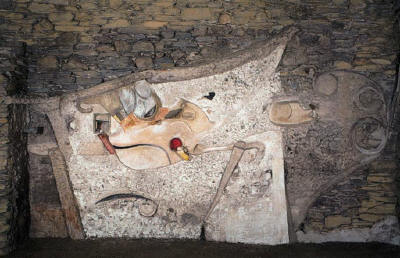
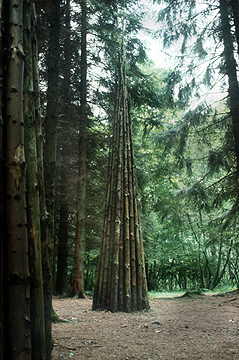
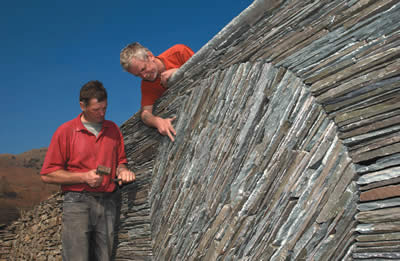
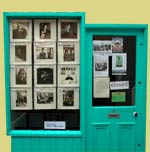 Fold
is an artist-led organisation that aims to provide and promote access to
contemporary art in the rural environment. It started with just the two
of us – myself and my partner Richeldis. There are now rather a few more
than that involved. We have a small committee who help steer the major
decisions and keep it all legal. Other than that, we generally programme
all the shows and events ourselves. Experience has shown that curating
by committee is never a good thing.
Fold
is an artist-led organisation that aims to provide and promote access to
contemporary art in the rural environment. It started with just the two
of us – myself and my partner Richeldis. There are now rather a few more
than that involved. We have a small committee who help steer the major
decisions and keep it all legal. Other than that, we generally programme
all the shows and events ourselves. Experience has shown that curating
by committee is never a good thing. 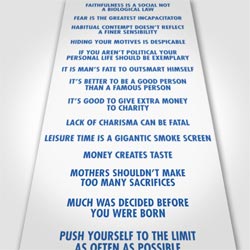
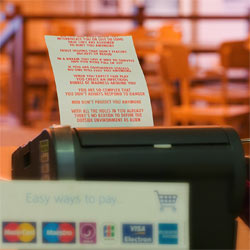
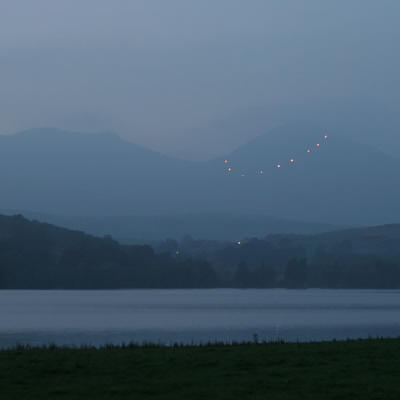
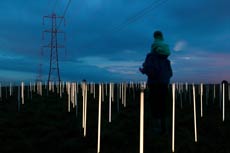 The Observer put us ahead of Frieze Art fair in London in its 50
cultural events of the autumn – worldwide.
The Observer put us ahead of Frieze Art fair in London in its 50
cultural events of the autumn – worldwide.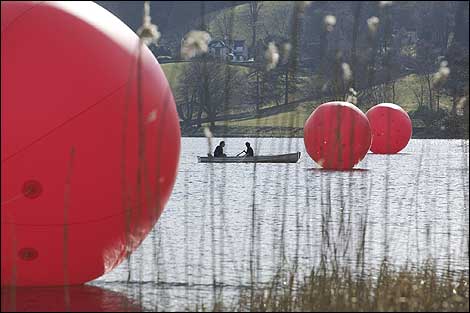
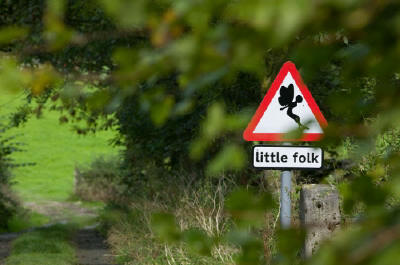 I
think the work has also helped FRED over the years as a project many
people saw and actually loved the effect. It’s more akin to the work of
Christo and Jeanne Claude than Goldsworthy. Artificial work that
I
think the work has also helped FRED over the years as a project many
people saw and actually loved the effect. It’s more akin to the work of
Christo and Jeanne Claude than Goldsworthy. Artificial work that
 As
mentioned before, FRED is a very media-friendly event. Last year we got
more column inches outside the specialist art market than the Liverpool
Biennial. The art mags, however largely leave us alone. That’s probably
more to do with the fact that we don’t place ads anywhere and that’s how
publishing works than anything else. I used to be a picture editor for a
music magazine and I know how editorial content is governed. We’re also
in the wrong part of the country for writers. Artists Newsletter wanted
to do a review on FRED (we placed our only ad with them last year) but
the only writer who could cover it happened to be one of the artists
taking part and one of the FRED team to boot.
As
mentioned before, FRED is a very media-friendly event. Last year we got
more column inches outside the specialist art market than the Liverpool
Biennial. The art mags, however largely leave us alone. That’s probably
more to do with the fact that we don’t place ads anywhere and that’s how
publishing works than anything else. I used to be a picture editor for a
music magazine and I know how editorial content is governed. We’re also
in the wrong part of the country for writers. Artists Newsletter wanted
to do a review on FRED (we placed our only ad with them last year) but
the only writer who could cover it happened to be one of the artists
taking part and one of the FRED team to boot. 